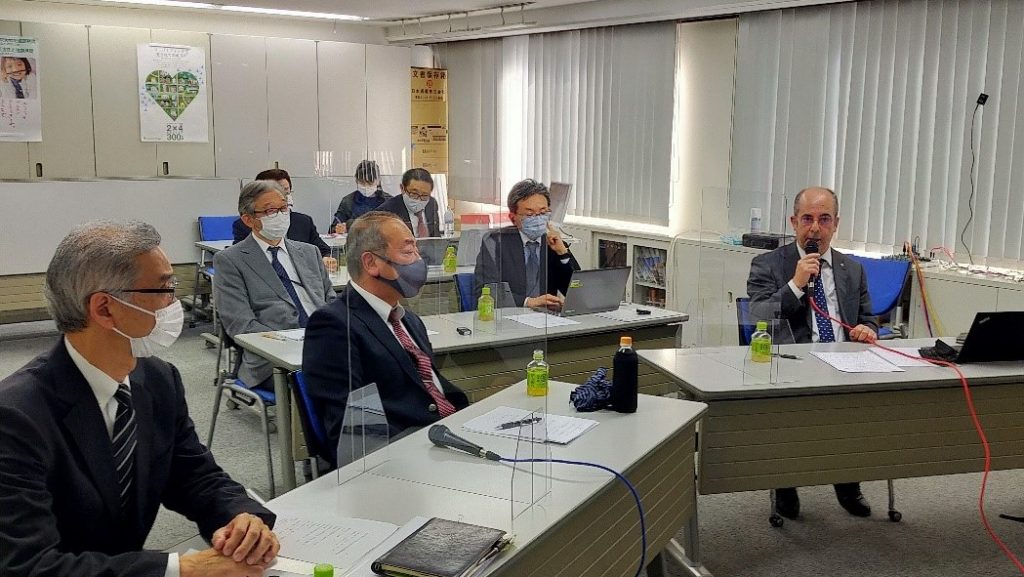Global Wood Market Trends & Outlook: Joint COFI & Japan 2×4 Home Builders Association Virtual Symposium

On March 18th COFI Tokyo collaborated with the Japan 2×4 Home Builders Association to hold a virtual information exchange session on the “Global Wood Market Trends & Outlook” between Japan’s 2×4 housing industry and Canadian forest products industry representatives. A total of 24 industry representatives took part in the hybrid online/in-person event. Canadian forest industry representation included presentations from George Omori of Western Forest Products, Soichiro Utsunomiya of Interfor and Kevin Minegishi of Interex Forest Products. Other Canadian representatives from Canfor, West Fraser, Weyerhaeuser and Tiger International also took part in discussions. The information session was held to help Japanese builders make sense of the sudden global wood market changes and provide forward guidance to our key stakeholders as they navigate through a tightening global wood supply scenario. This article offers an overview of the key points discussed and provides some supplementary notes and analysis by the author.
A Surge in Global Wood Demand Leads to Record-Breaking Prices
On March 12th, the leading North American lumber market indicator Random Lengths Composite Price Index reached an unprecedented high of US $1,044 per thousand board feet. What factors are behind this surge? What implications does this have for Japan’s housing industry? Several key factors driving current lumber markets were identified. We discern the following three key themes: changes in global demand, changes in global supply and global transportation constraints.
Changes in Global Demand
The Covid-19 pandemic and associated government stimulus measures are turbo-charging growth in the U.S. housing market. The structural shift to telework is triggering a migration away from multi-family dwellings in urban areas to more affordable single-family homes in the suburbs. Lockdown measures and government stimulus cheques have boosted consumer savings. This in turn is leading to a surge in home improvements – from renovating exterior decks to building home office additions. Quick monetary policy intervention by the U.S. Federal Reserve resulted in mortgage interest rates to plunge to historical lows – hovering now at just over 3%. Even as the dramatic run up in timber prices have added an estimated US $24,000 to the average house price, lower mortgage rates are more than enough to compensate for the difference. Housing affordability remains the best it has been in years.
This additional stimulus is on top of a North American housing market with strong fundamentals. Since the 2008 Global Financial Crisis, the US housing market has steadily recovered: increasing 7% to 1.38 million starts in 2020. Projections for 2021 are at 1.58 million starts and the general equilibrium level of intrinsic demand for the US market is thought to be at 1.6 million starts annually. Canada’s housing market is also showing strong fundamentals: increasing 4.4% in 2020 to 218,000 units, with a 2021 forecast projected to increase to 282,000 starts.
European economies are also projected to recover. In 2021 European softwood lumber consumption is forecast to grow by 3.5 million m3 to 87.4 million m3. Strengthening demand from China is also playing a pivotal role in global lumber demand. In 2020 as buyers from China were unable to travel overseas on purchasing trips, log and lumber inventories depleted. Between early fall of 2020 to January 2021 softwood lumber inventory in the greater Shanghai area fell from 1.5 million m3 to 600,000m3. China is looking to aggressively expand imports from New Zealand, North America, Europe and even Japan. To put it into context China imports 29.7 million m3 of timber annually and combined with US annual imports of 24.5 million m3, China and the US together import 10 times Japan’s annual imports of 5.5 million m3. In 2021 GDP is expected to grow 4.7% in the United Sates and 8.2% in China. Other nations are also forecasting strong recoveries in what is a rare instance when the world’s leading economies are all simultaneously synchronized for growth.
Changes in Global Supply
During the last U.S. housing market bubble in the mid 2000’s record demand triggered increased production from mills across Canada and the U.S. Much of this increased production was met with of a temporary uplift in annual allowable cut (AAC) in British Columbia to conduct salvage logging of mountain pine beetle (MPB) affected timber: in early 2000’s B.C.’s AAC was temporarily increased from 70 million to up to 85 million m3 annually. But as the salvage logging operations are now largely behind us, B.C.’s AAC has moderated down to more historical average and is currently at just under 65 million m3 annually. To ensure long term sustainability of the forests, B.C.’s annual allowable cut is forecast at around 60 million m3 by mid decade. In short additional fibre capacity from Canada to meet growing U.S. demand is limited at best. Indeed, if we compare 2020 versus 2019 U.S. softwood lumber imports from Canada, the volume is flat at 13 billion board feet despite higher market prices
Looking at the U.S., 2020 production increased 2% or about by 700 million board feet, but the increase was unable to keep up with surging demand. How is this gap being filled? Two trends are manifest and both carry supply implications for Japan. First, US log and lumber exports are falling as more wood is consumed locally. Between 2018, U.S. lumber exports fell by 33% from 1.4 to 0.9 billion board feet. Second, European dimension lumber supply to the U.S. is undergoing robust growth. In 2020 German, Swedish and Austrian lumber exports to the U.S. increased 42%, 72% and 48% respectively. Total 2020 European exports to the US increased by 476.5 million board feet. Meanwhile European softwood exports to Japan declined 180,000m3 to 2.38 million m3 in 2020.
In 2021 European softwood lumber production is expected to grow by 3.2 million m3, but will fall short of meeting the forecasted increase in consumption. It is also noteworthy that much of the increased European production is thanks to salvage logging of Spruce beetle damaged timber which is inherently unsuitable for manufacturing Whitewood lamina or Mabashira. Russia remains a formidable potential global forest products supplier and with the ban on log exports to take effect next year we may eventually see increased softwood production. However, with Russian log and lumber imports into Japan falling 54.9% and 16.8% respectively in 2020 a near term reversal of this situation is unlikely.
To be sure Japanese domestic log production has room to increase. However, domestic log production is estimated to have decreased about 3% in 2020 to 21.6 million m3. Domestic sawmills are facing competition from log exports, as well as plywood mills and biomass operators. Japan log exports to China, Korea and Taiwan have grown fourfold from 650,000m3 annually in 2016 to 1,384,000m3 in 2020. Similarly, Japan annual lumber exports increased from 87,000m3 in 2016 to 173,000m3 in 2020. Increased domestic harvest in Japan does not necessarily equate to rising lumber availability for domestic use. In short, at present there appears to be no readily apparent source of global timber supply ready to step in to cool off accelerating demand. Tightening supply is also altering global timber trade flows.
Global Transportation Constraints
An additional factor impacting wood markets is the global shortage of vessels and containers. The pandemic has impacted ports due to labour shortages and have curtailed the number of containers and ships in operation. As manufacturers in China gear up for recovery in the U.S. and Europe, a number of shipping companies are quickly returning containers to China empty to service higher valued consumer exports. Container rates from China to the US West Coast have more than doubled to over $4,000 in the past year, resulting in shortages of containers available for return bound traffic. Shipping delays and declining container availability has led to eroding of port timber inventories in Japan and other Asian countries. As an example, Tokyo Lumber Terminal month end inventory of global imported wood has fallen by nearly half: from 145,495m3 in January 2020 to 76,675m3 in January 2021. Industry observers expect that it will take until the end of this calendar year for container availability to normalize.
Global Timber Market Outlook & Implications for the Japan Market
How long is the recent surge in lumber prices expected to continue? Record pricing cannot last forever and if we look at current North American Western #2&Btr. futures as one indicator, prices are expected to moderate from the high $900 level to the high $700 level by mid-summer 2021. Rising interest rates and worsening affordability is expected to eventually tap the brakes on housing demand, however, indications from the U.S. Federal Reserve suggest interest rates will remain low for the foreseeable future. Overall, the alignment of strong global demand fundamentals, depleted inventories, limited near term prospects for significant increases in supply and transportation constraints are expected to support strong pricing fundamentals.
What are the implications for Japan? Available supply to Japan from North America and Europe has been declining. The gap between Japanese and global market prices remains large. In the case of SPF, J-Grade is the top-quality grade that Canadian mills produce and it historically has traded at a market premium to cover additional manufacturing and shipping costs over the North American market alternative. However, since the summer of 2020 Japan market pricing for SPF J-Grade has consistently trailed North American #2&Btr. prices. Canadian shippers are maintaining their long-term commitments to the Japan market; however, a widening gap with U.S. and other global markets pricing may play a factor in limiting J-Grade shipments to Japan. Greater flexibility and understanding of these global market dynamics among our key stakeholders in Japan would be helpful in alleviating volume shortfalls.
Global timber price increases are not only restricted to North American dimension lumber, but are impacting Zairai components as well. For example, Douglas Fir log export prices from the Pacific Northwest to Japan have jumped 25% since last summer. While 2020 log volumes were steady, US sawn wood exports to Japan declined 21.4% as a number of Zairai specialty mills shifted production to focus on the domestic market. The case is not dissimilar with European softwood exporters increasingly focused on shipping dimension to North America and curtailing Zairai program exports to Japan. European lamina, mabashira and engineered wood prices are also undergoing double digit price increases. It is important to understand that tightening of global wood supply is impacting Japanese traditional post and beam construction as well as 2×4 construction. While construction activity in Japan remains modest, everything is connected: supply and demand dynamics are exercising inflationary pressures globally.
Markets go up and markets go down. In our March 18th virtual symposium Canadian industry representatives reaffirmed their strategy of commitment to the Japan market for the long term, just as they have over the past five decades. In time global timber prices are expected to moderate from peak levels, however it is important to recognize that stable export programs are underpinned by fair and internationally competitive market prices.


